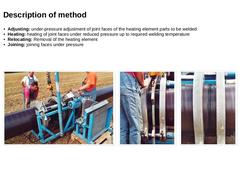
|

- Adjusting: under-pressure adjustment of joint faces of the heating element parts to be welded
- Heating: heating of joint faces under reduced pressure up to required welding temperature
- Relocating: Removal of the heating element
- Joining: joining faces under pressure
|
(Image: Heating element butt welding device)
|
(Image: Welding of the HD-PE long pipes into continuous pipes)
|
(Image: Welding of the HD-PE long pipes into continuous pipes)
|
|
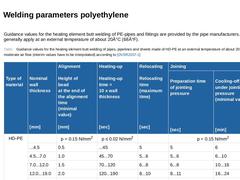
|

|
Guidance values for the heating element butt welding of PE-pipes and fittings are provided by the pipe manufacturers. They generally apply at an external temperature of about 20°C (68°F). (Table: Guidance values for the heating element butt welding of pipes, pipelines and sheets made of HD-PE at an external temperature of about 20°C and moderate air flow (interim values have to be interpolated) according to [DVSR2207-1]) |
|
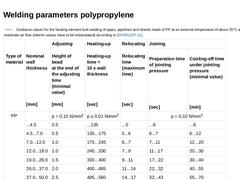
|

(Table: Guidance values for the heating element butt welding of pipes, pipelines and sheets made of PP at an external temperature of about 20°C and moderate air flow (interim values have to be interpolated) according to [DVSR2207-11]) |
|
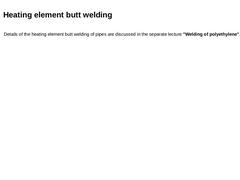
|

|
Details of the heating element butt welding of pipes are discussed in the separate lecture "Welding of polyethylene". |
|
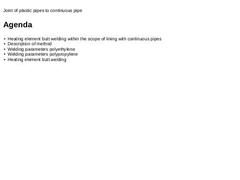
|

|
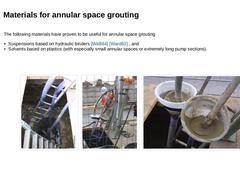
|

|
The following materials have proven to be useful for annular space grouting: - Suspensions based on hydraulic binders [Walli84] [Ward82] ; and
- Solvents based on plastics (with especially small annular spaces or extremely long pump sections).
|
(Image: Grouting – view into the excavation)
|
(Image: Grouting - hanging the grouting hoses into the grouting funnels)
|
(Image: Grouting - grouting funnels with sieves)
|
|
|
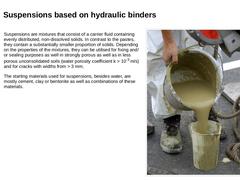
|

| (Image: Suspensions based on hydraulic binders)
Suspensions are mixtures that consist of a carrier fluid containing evenly distributed, non-dissolved solids. In contrast to the pastes, they contain a substantially smaller proportion of solids. Depending on the properties of the mixtures, they can be utilised for fixing and/or sealing purposes as well in strongly porous as well as in less porous unconsolidated soils (water porosity coefficient k > … |
|
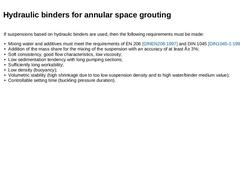
|

|
If suspensions based on hydraulic binders are used, then the following requirements must be made: - Mixing water and additives must meet the requirements of EN 206 [DINEN206:1997] and DIN 1045 [DIN1045-1:1997] ;
- Addition of the mass share for the mixing of the suspension with an accuracy of at least ± 3%;
- Soft consistency, good flow characteristics, low viscosity;
- Low sedimentation tendency with long pumping sections;
- Sufficiently long workability;
|
|
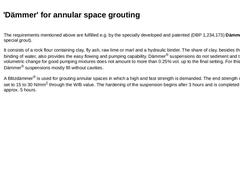
|

|
The requirements mentioned above are fulfilled e.g. by the specially developed and patented (DBP 1,234,173) Dämmer® (or special grout). It consists of a rock flour containing clay, fly ash, raw lime or marl and a hydraulic binder. The share of clay, besides the good binding of water, also provides the easy flowing and pumping capability. Dämmer® suspensions do not sediment and the volumetric change for good pumping mixtures does not amount to more … |
|
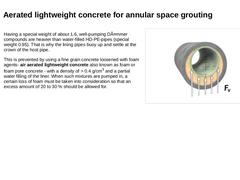
|

| (Image: Buoyancy force Fv with reference to [FI-Hoech] [Koch85] [Bild: S&P GmbH])
Having a special weight of about 1.6, well-pumping Dämmer compounds are heavier than water-filled HD-PE-pipes (special weight 0.95). That is why the lining pipes buoy up and settle at the crown of the host pipe. This is prevented by using a fine grain concrete loosened with foam agents- air aerated lightweight concrete also known as foam or foam pore concrete - with … |
|
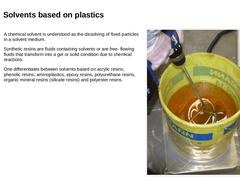
|

| (Image: Mixing the reaction resin)
A chemical solvent is understood as the dissolving of fixed particles in a solvent medium. Synthetic resins are fluids containing solvents or are free- flowing fluids that transform into a gel or solid condition due to chemical reactions. One differentiates between solvents based on acrylic resins, phenolic resins, aminoplastics, epoxy resins, polyurethane resins, organic mineral resins (silicate resins) and polyester … |
|
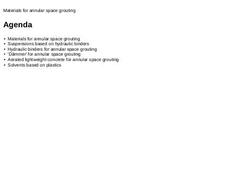
|

|

|

In this module, the fundamentals of the materials applied in the lining processes with continuous pipes are presented and discussed. |
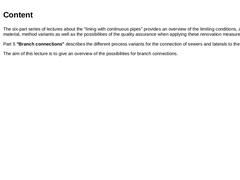
|

The six-part series of lectures about the "lining with continuous pipes" provides an overview of the limiting conditions, applied material, method variants as well as the possibilities of the quality assurance when applying these renovation measures. Part 5 "Branch connections" describes the different process variants for the connection of sewers and laterals to the liner. The aim of this lecture is to give an overview of the possibilities for branch … |
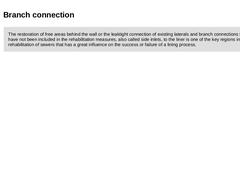
|

|
The restoration of free areas behind the wall or the leaktight connection of existing laterals and branch connections that have not been included in the rehabilitation measures, also called side inlets, to the liner is one of the key regions in the rehabilitation of sewers that has a great influence on the success or failure of a lining process. |
|
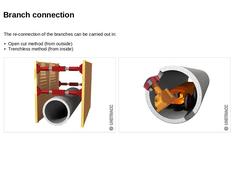
|

|
The re-connection of the branches can be carried out in: - Open cut method (from outside)
- Trenchless method (from inside)
| |
(Image: Open cut method)
|
(Image: Repair)
|
|
|

|

|
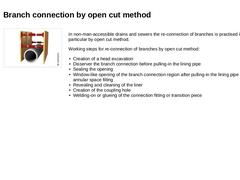
|

| (Image: Open cut method)
|
In non-man-accessible drains and sewers the re-connection of branches is practised in particular by open cut method. Working steps for re-connection of branches by open cut method: - Creation of a head excavation
- Disserver the branch connection before pulling-in the lining pipe
- Sealing the opening
- Window-like opening of the branch connection region after pulling-in the lining pipe and annular space filling
- Revealing and cleaning …
|
|
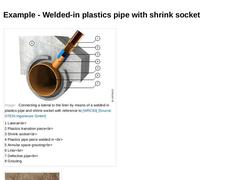
|

| (Image: Connecting a lateral to the liner by means of a welded-in plastics pipe and shrink socket with reference to [WRC83] [Image: S&P GmbH])
| | (Image: Welded-on PE-nozzle [Jürge05])
|
|
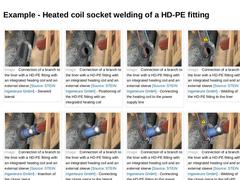
|

|
(Image: Connection of a branch to the liner with a HD-PE fitting with an integrated heating coil and an external sleeve - Severed lateral)
|
(Image: Connection of a branch to the liner with a HD-PE fitting with an integrated heating coil and an external sleeve - Positioning of the HD-PE fitting with an integrated heating coil)
|
(Image: Connection of a branch to the liner with a HD-PE fitting with an integrated heating coil and an external sleeve - … |
|
|
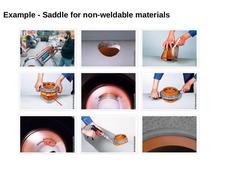
|

|
(Image: Fabekun® saddle with ball joint - core drilling [FI-Funke])
|
(Image: Fabekun® saddle with ball joint - installation position [FI-Funke])
|
(Image: Fabekun® saddle with ball joint - application of the lubricant [FI-Funke])
|
|
(Image: Fabekun® saddle with ball joint - installation [FI-Funke])
|
(Image: Fabekun® saddle with ball joint - installation [FI-Funke])
|
(Image: Fabekun® saddle with ball joint - tightening the grey threaded ring [FI-… |
|
|
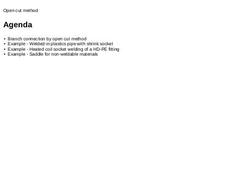
|

|
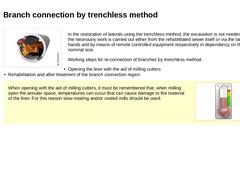
|

| (Image: Repair)
In the restoration of laterals using the trenchless method, the excavation is not needed as all the necessary work is carried out either from the rehabilitated sewer itself or via the lateral by hands and by means of remote controlled equipment respectively in dependency on the nominal size. Working steps for re-connection of branches by trenchless method: - Opening the liner with the aid of milling cutters
- Rehabilitation and after treatment …
|
|
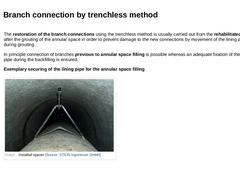
|

|
The restoration of the branch connections using the trenchless method is usually carried out from the rehabilitated sewer after the grouting of the annular space in order to prevent damage to the new connections by movement of the lining pipes during grouting. In principle connection of branches previous to annular space filling is possible whereas an adequate fixation of the lining pipe during the backfilling is ensured. Exemplary securing of the … |
|
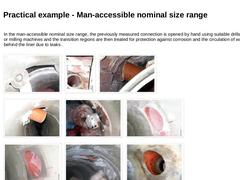
|

|
In the man-accessible nominal size range, the previously measured connection is opened by hand using suitable drills, cutting or milling machines and the transition regions are then treated for protection against corrosion and the circulation of water behind the liner due to leaks . | |
(Image: Milling open of the GRP pipe to connect a lateral)
|
(Image: Window milled open with lateral)
|
(Image: Pushing the PVC-KG pipe into the lateral that is to be … |
|
|